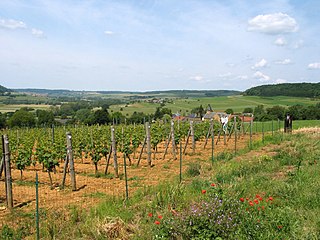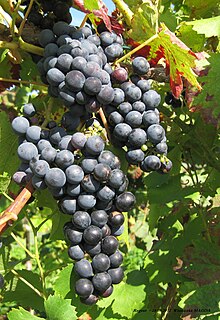
Aurore is a white complex hybrid grape variety produced by Albert Seibel and used for wine production mostly in the United States and Canada. Over a long lifetime Seibel produced many complex hybrid crosses of Vitis vinifera to American grapes. It is a cross of Seibel 788 and Seibel 29.

Vitis vinifera, the common grape vine, is a species of flowering plant, native to the Mediterranean region, Central Europe, and southwestern Asia, from Morocco and Portugal north to southern Germany and east to northern Iran. There are currently between 5,000 and 10,000 varieties of Vitis vinifera grapes though only a few are of commercial significance for wine and table grape production.

Dornfelder is a dark-skinned variety of grape of German origin used for red wine. It was created by August Herold (1902–1973) at the grape breeding institute in Weinsberg in the Württemberg region in 1955. Herold crossed the grape varieties Helfensteiner and Heroldrebe, the latter which bears his name, to create Dornfelder. Helfensteiner and Heroldrebe were both crosses created some decades earlier by Herold. Dornfelder received varietal protection and was released for cultivation in 1979. It was named in honor of Immanuel August Ludwig Dornfeld (1796–1869), a senior civil servant who was instrumental in creating the viticultural school in Weinsberg.

Bacchus is a white wine grape created by viticulturalist Peter Morio at the Geilweilerhof Institute for Grape Breeding in the Palatinate in 1933. He crossed a Silvaner x Riesling cross with Müller-Thurgau.

Müller-Thurgau is a white grape variety which was created by Hermann Müller from the Swiss Canton of Thurgau in 1882 at the Geisenheim Grape Breeding Institute in Germany. It is a crossing of Riesling with Madeleine Royale. It is used to make white wine in Germany, Austria, Northern Italy, Hungary, England, Australia, the Czech Republic, Slovakia, Slovenia, New Zealand, Canada, the United States, Belgium and Japan. There are around 22,201 hectares ) cultivated worldwide, which makes Müller-Thurgau the most widely planted of the so-called "new breeds" of grape varieties created since the late 19th century. Although plantings have decreased significantly since the 1980s, as of 2019 it was still Germany's second most planted variety at 11,400 hectares and 11.4% of the total vineyard surface. In 2007, the 125th anniversary was celebrated at the Geisenheim Grape Breeding Institute. Müller-Thurgau is also known as Rivaner, Riesling x Sylvaner, Riesling-Sylvaner, Rizvanec (Slovenia) and Rizlingszilváni (Hungary).

Vitis riparia Michx, with common names riverbank grape or frost grape, is a vine indigenous to North America. As a climbing or trailing vine, it is widely distributed across central and eastern Canada and the central and northeastern parts of the United States, from Quebec to Texas, and eastern Montana to Nova Scotia. There are reports of isolated populations in the northwestern USA, but these are probably naturalized. It is long-lived and capable of reaching into the upper canopy of the tallest trees. It produces dark fruit that are appealing to both birds and people, and has been used extensively in commercial viticulture as grafted rootstock and in hybrid grape breeding programs.

Vitis rupestris is a species of grape native to the United States that is known by many common names including July, Coon, sand, sugar, beach, bush, currant, ingar, rock, and mountain grape. It is used for breeding several French-American hybrids as well as many root stocks.

Hybrid grapes are grape varieties that are the product of a crossing of two or more Vitis species. This is in contrast to crossings between grape varieties of the same species, typically Vitis vinifera, the European grapevine. Hybrid grapes are also referred to as inter-species crossings or "Modern Varieties." Due to their often excellent tolerance to powdery mildew, other fungal diseases, nematodes, and phylloxera, hybrid varieties have, to some extent, become a renewed focus for European breeding programs. The recently developed varieties are examples of newer hybrid grape varieties for European viticulturalists. Several North American breeding programs, such as those at Cornell and the University of Minnesota, focus exclusively on hybrid grapes, with active and successful programs, having created hundreds if not thousands of new varieties.

Siegerrebe is a white wine grape that is grown primarily in Germany with some plantings in England, Vancouver Island, Washington state, British Columbia's North Okanagan and Fraser Valley and Nova Scotia's Annapolis Valley along with a small planting in Tasmania, Australia at Every Man and His Dog Vineyard. Siegerrebe was created by German viticulturalist Dr. Georg Scheu (1879-1949) in 1929 at a grape-breeding institute in Alzey in Rheinhessen, by crossing Madeleine Angevine and Gewürztraminer. However, Georg Scheu's son Heinz Scheu has claimed in a book that Siegerrebe was the result of self-pollination of Madeleine Angevine. Siegerrebe received varietal protection and was released for general cultivation in Germany in 1958.

The Delaware grape is a cultivar derived from the grape species Vitis labrusca or 'Fox grape' which is used for the table and wine production.

Solaris is a variety of grape used for white wine. It was created in 1975 at the grape breeding institute in Freiburg, Germany by Norbert Becker.

Domina is a dark-skinned variety of grape used for red wine. It was created by German viticulturalist Peter Morio at the Geilweilerhof Institute for Grape Breeding in the Palatinate in 1927 by crossing the varieties Blauer Portugieser and Pinot noir.
Orion is a white wine grape variety of German origin. It was created by Dr. Gerhardt Alleweldt (1927-2005) at the Geilweilerhof Institute for Grape Breeding in Siebeldingen in 1964, by crossing the Vitis vinifera variety Optima with the hybrid grape Villard Blanc. Therefore, Orion is itself a hybrid grape rather than a pure Vitis vinifera.
This glossary of viticultural terms list some of terms and definitions involved in growing grapes for use in winemaking.

Belgian wine is produced in several parts of Belgium and production, although still modest at 1,400 hectoliters in 2004, has expanded in recent decades.

Cabernet Cortis is a dark-skinned grape variety used for wine. It was bred in 1982 by Norbert Becker at the viticultural institute in Freiburg, Germany as part of a programme searching for disease-resistant grape varieties. It received German varietal protection in 2003.

Phoenix is a white variety of grape of German origin used for wine. It was created by Dr. Gerhardt Alleweldt (1927–2005) at the Geilweilerhof Institute for Grape Breeding in Siebeldingen in 1964, by crossing the Vitis vinifera variety Bacchus with the hybrid grape Villard Blanc.

Olmo grapes are wine and table grape varieties produced by University of California, Davis viticulturist Dr. Harold Olmo. Over the course of his nearly 50-year career, Dr. Olmo bred a wide variety of both grapes by means of both crossing varieties from the same species or creating hybrid grapes from cultivars of different Vitis species.
Ravat blanc is a white hybrid grape variety that is a crossing of Chardonnay and a Seibel grape. While the Vitis International Variety Catalogue (VIVC) maintained by the Geilweilerhof Institute for Grape Breeding list Seibel 5474 as the second parent, Master of Wine Jancis Robinson notes that other authors list Seibel 8724 as the parent. The grape is often confused with the white hybrid grape Vignoles that is often called just Ravat.
Cabernet blanc is a white German and Swiss wine grape variety that is a crossing of the French wine grape Cabernet Sauvignon and Regent. The grape was bred by Swiss grape breeder Valentin Blattner in 1991. Cabernet blanc has strong resistance to most grape disease including botrytis bunch rot, downy and powdery mildew and tends to produce loose clusters of small, thick-skinned grape berries which can hang on the vine late into the harvest season to produce dessert wines. Today the grape is found primarily in the Palatinate wine region of Germany with some experimental plantings in Spain and the Netherlands. In France, in the Languedoc, Domaine La Colombette is heavily investing in PIWI grapes. Amongst others the Cabernet Blanc in their cuvée "Au Creux du Nid", is gaining wide acclaim.

















